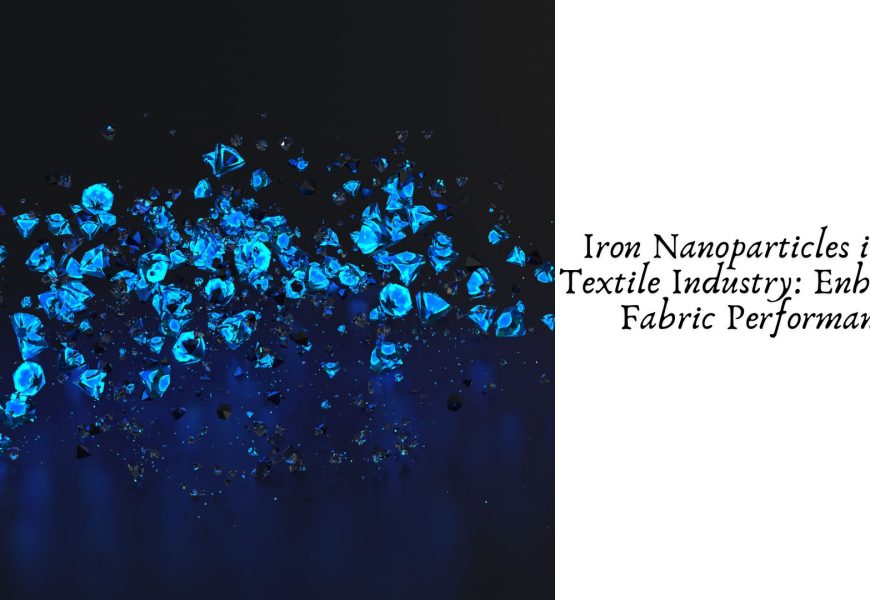The textile industry has undergone significant transformation in recent decades, with advances in nanotechnology playing a pivotal role. Among the most promising materials being integrated into fabrics are iron nanoparticles, which have introduced new functionalities and performance enhancements to textiles. From improving fabric durability to providing advanced properties such as antimicrobial activity and UV protection, iron nanoparticles are revolutionizing the textile sector. This article explores how iron nanoparticles are enhancing fabric performance and what the future holds for this technology.
What Are Iron Nanoparticles?
Iron nanoparticles (FeNPs) are ultra-small particles of iron, typically ranging from 1 to 100 nanometers in size. At this nanoscale, iron exhibits unique properties that differ from its bulk counterpart. Iron nanoparticles are often coated with protective layers to prevent oxidation and ensure their functionality when applied to various materials. These nanoparticles have gained attention in multiple industries, including medicine, electronics, environmental remediation, and textiles.
Key Advantages of Using Iron Nanoparticles in Textiles
Incorporating iron nanoparticles into textiles brings several benefits, some of which have transformative implications for the fabric’s overall performance. Here are some of the primary advantages:
- Antimicrobial Properties: Iron nanoparticles exhibit antimicrobial effects, which can prevent the growth of bacteria, fungi, and other harmful microorganisms. This property is particularly beneficial for textiles used in healthcare settings, sportswear, and outdoor gear. By integrating iron nanoparticles, textiles can become self-sterilizing, reducing odors and preventing infections.
- Enhanced Durability and Strength: Fabrics treated with iron nanoparticles have shown improved mechanical properties, such as tensile strength and resistance to wear and tear. These nanoparticles reinforce the fibers, making the fabric more durable and extending its lifespan. This property is crucial for textiles used in demanding environments like military uniforms, workwear, and outdoor equipment.
- UV Protection: Another significant advantage of iron nanoparticles is their ability to block ultraviolet (UV) rays. By incorporating these nanoparticles into clothing, manufacturers can create fabrics that offer UV protection, shielding wearers from harmful sun exposure. This feature is highly desirable for outdoor clothing, swimwear, and even everyday garments.
- Thermal Regulation: Iron nanoparticles can enhance a fabric’s thermal properties. They can absorb, store, and release heat, allowing textiles to regulate temperature more effectively. This characteristic is particularly useful in creating smart fabrics for athletic wear, bedding, and clothing designed for extreme weather conditions.
- Stain and Water Resistance: Fabrics treated with iron nanoparticles can also become more resistant to stains and water. The nanoparticles create a barrier that prevents liquids and dirt from penetrating the fibers, making the fabric easier to clean. This is especially advantageous for upholstery, outdoor gear, and everyday clothing.
- Magnetic Properties: One of the unique features of iron nanoparticles is their magnetic nature. This property opens up possibilities for smart textiles, where fabrics can respond to external magnetic fields. Magnetic textiles have potential applications in wearable technology, medical devices, and sensors, providing real-time data and feedback to users.
Applications of Iron Nanoparticles in Textiles
Iron nanoparticles are being used across various textile applications, offering significant benefits in multiple domains. Below are some examples of how these nanoparticles are transforming specific types of fabrics:
- Healthcare Fabrics: In hospitals and healthcare settings, maintaining sterile environments is critical. Iron nanoparticles can be used in bed linens, hospital gowns, and surgical fabrics to provide antimicrobial protection. This reduces the risk of hospital-acquired infections and ensures a cleaner, safer environment for both patients and healthcare workers.
- Activewear and Sports Apparel: With the rise of performance-based activewear, incorporating iron nanoparticles into sports apparel can significantly enhance functionality. The antimicrobial properties reduce odor buildup caused by sweat, while the thermal regulation capabilities ensure that athletes stay comfortable in various weather conditions. Additionally, UV protection is essential for outdoor sports clothing.
- Military and Workwear: In harsh environments, clothing needs to withstand extreme conditions while keeping the wearer safe. Iron nanoparticles can increase the durability of military uniforms and workwear, making them more resistant to physical wear and tear. The added benefits of thermal regulation and UV protection are also valuable in these settings.
- Smart Fabrics: Iron nanoparticles’ magnetic properties make them suitable for smart textiles, which are gaining traction in the wearable tech market. These fabrics can be used in clothing that monitors health metrics, tracks movement, and interacts with external devices. For example, a jacket could communicate with a smartphone or medical device, providing real-time updates on vital signs.
- Protective Clothing: Iron nanoparticles can be used in protective clothing for firefighters, construction workers, and other professionals exposed to hazardous environments. By enhancing the fabric’s strength, thermal resistance, and UV protection, these garments offer better protection against fire, heat, and harmful radiation.
- Everyday Wear and Fashion: Even in everyday clothing, iron nanoparticles offer benefits such as stain resistance, antimicrobial properties, and UV protection. These features improve the functionality of casual wear, making garments more practical for daily use. Fashion designers are also beginning to explore the creative possibilities of iron nanoparticles, incorporating them into high-performance fabrics for innovative designs.
Environmental Impact and Sustainability Concerns
As with any new technology, the environmental impact of using iron nanoparticles in textiles must be carefully considered. While the performance benefits are clear, there are questions about the long-term effects of nanoparticles on the environment, particularly when fabrics containing them are washed or disposed of.
Iron nanoparticles may enter waterways through washing, leading to potential environmental hazards. Therefore, researchers are exploring eco-friendly methods for producing and coating these nanoparticles to mitigate any adverse effects. Moreover, efforts are underway to ensure that textiles treated with iron nanoparticles remain recyclable and do not contribute to landfill waste.
The Future of Iron Nanoparticles in Textiles
The future of iron nanoparticles in the textile industry looks promising, with ongoing research focused on enhancing their properties and expanding their applications. As smart textiles and wearable technology become more mainstream, the magnetic properties of iron nanoparticles could play a significant role in developing interactive garments. Furthermore, advancements in sustainable nanoparticle production will address environmental concerns, making the technology more viable for large-scale use.
Additionally, as the demand for multifunctional fabrics grows, manufacturers will likely explore more innovative ways to integrate iron nanoparticles into a broader range of textiles, from everyday clothing to specialized protective gear. Collaboration between nanotechnology experts, textile manufacturers, and designers will be essential in bringing these advanced fabrics to market.
Conclusion
Iron nanoparticles are revolutionizing the textile industry by enhancing fabric performance in ways that were previously unimaginable. From antimicrobial protection to improved durability and UV resistance, these nanoparticles offer numerous benefits across various textile applications. As research and development continue, we can expect to see even more innovative uses for iron nanoparticles in fabrics, potentially transforming the way we think about clothing and textiles in the future. However, it is crucial to address environmental and sustainability concerns to ensure that this technology is both beneficial and eco-friendly.








